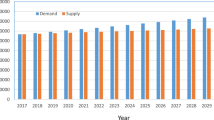Abstract
BACKGROUND: Although there have been many studies of the health care services that resident physicians provide, little is known about the health care services they receive.
OBJECTIVE: To describe residents’ perceptions of the health care they receive.
DESIGN: Anonymous mailed survey.
SUBJECTS: All 389 residents in four U.S. categorical internal medicine training programs.
MAIN RESULTS: Three hundred sixteen residents responded (83%). In aggregate, 116 (37%) reported having no primary care physician, and 36 (12%) reported that they are their own primary care physician. These figures varied substantially across the four programs. Most residents reported receiving basic screening and preventive services; however, their attitudes toward their health and health care differed across postgraduate level, gender, and program. Many residents reported that their long and unpredictable hours interfered with their ability to schedule clinician visits, that their health had declined because of residency, that programs and other residents were unsupportive of residents’ health care needs, and that residency raised special issues of privacy that limited access to health care.
CONCLUSIONS: Despite high rates of receipt of preventive services, these internal medicine residents identified several barriers that limited their access to health care. Program directors should explore these barriers and, at the same time, reevaluate the messages being sent to resident physicians about maintaining their health and health care.
Similar content being viewed by others
References
Bosk CL. Forgive and Remember: Managing Medical Failure. Chicago, Ill: University of Chicago Press; 1979.
Wells KB, Lewis CE, Leake B, et al. Do physicians preach what they practice? JAMA. 1984;252:2846–8.
Lewis CE, Wells KB, Ware JE. A model for predicting the counseling practices of physicians. J Gen Intern Med. 1986;1:14–9.
Asch DA. Use of a coded post card to maintain anonymity in a highly sensitive mail survey: cost, response rates, and bias. Epidemiology. 1996;7:550–1.
Christie JD, Rosen IM, Bellini LM, et al. Prescription drug use and self-prescription among housestaff in four U.S. internal medicine programs. JAMA. 1998;280:1253–5.
Kahn KL, Goldberg RJ, DeCosimo D, Dalen JE. Health maintenance activities of physicians and nonphysicians. Arch Intern Med. 1988;148:2433–6.
Bennett WI. What doctors do—ten years after. Harvard Health Letter. 1992;Suppl:9–12.
Wyshak G, Lamb GA, Lawrence RS, Curran WJ. A profile of the health-promoting behaviors of physicians and lawyers. N Engl J Med. 1980;303:104–7.
Sargent DA, Jensen VW, Petty TA, Raskin H. Preventing physician suicide: the role of family, colleagues and organized medicine. JAMA. 1977;237(2):143–7.
Allibone A, Oakes D, Shannon HS. The health and health care of doctors. J R Coll Gen Pract. 1981;31:728–34.
Stoudemire A, Rhoads JM. When the doctor needs a doctor: special considerations for the physician-patient. Ann Intern Med. 1983;98:654–9.
Sharpe JC, Smith WW. Physician, heal thyself: comparison of findings in periodic health examinations of physicians and executives. JAMA. 1962;182:234–7.
Shangold MM. The health care of physicians: “Do as I say and not as I do”. J Med Educ. 1979;54:668.
Valko RJ, Clayton PJ. Depression in the internship. Dis Nerv Syst. 1975;36:26–9.
Council on Mental Health. The sick physician: impairment by psychiatric disorders, including alcoholism and drug dependence. JAMA. 1973;223(6):684–7.
Russek HI. Emotional stress and coronary heart disease in American physicians, dentists and lawyers. Am J Med Sci. 1962;243:716–25.
McCue JD. The effects of stress on physicians and their medical practice. N Engl J Med. 1982;306(8):458–63.
Ross M. Suicide among physicians. Psychiatry Med. 1971;2:189–98.
Rose KD, Rosow I. Physicians who kill themselves. Arch Gen Psychiatry. 1973;29:800–5.
Duffy JC, Litin EM. Psychiatric morbidity of physicians. JAMA. 1966;189:989–92.
Author information
Authors and Affiliations
Corresponding author
Additional information
This work was supported in part by SmithKline Beecham and the Greenwall Foundation. Dr. Asch is a Department of Veterans Affairs Health Services Research and Development Senior Research Associate.
Rights and permissions
About this article
Cite this article
Rosen, I.M., Christie, J.D., Bellini, L.M. et al. Health and health care among housestaff in four U.S. internal medicine residency programs. J GEN INTERN MED 15, 116–121 (2000). https://doi.org/10.1046/j.1525-1497.2000.11218.x
Published:
Issue Date:
DOI: https://doi.org/10.1046/j.1525-1497.2000.11218.x




